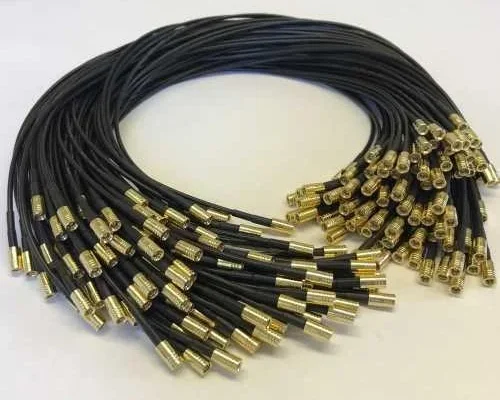In the world of tech, picking the right cable assemblies is key. Engineers and project managers must decide between standard and custom cable assemblies. These choices affect a project’s success.
Standard cables fit all, but custom cables are made for specific needs. Industries like telecom, auto, and medicine need cables that fit their exact needs.
Choosing the right cable assembly is critical for modern tech systems. Custom cables let engineers create solutions that fit perfectly. This avoids the limits of standard parts.
Key Takeaways
- Custom cable assemblies provide targeted performance solutions
- Standard cables offer quick, cost-effective alternatives
- Project requirements determine optimal cable assembly selection
- Technical specifications drive cable design choices
- Industry-specific needs influence cable assembly development
Understanding Cable Assembly Basics
Cable assemblies are complex electrical systems. They connect and transmit power in many ways. They have several key parts that work together for reliable performance.
The basic parts of a cable assembly include electrical conductors covered by special materials. These conductors carry electrical signals well. There are various types of cable assemblies, which differ based on project requirements.
- Conductors: Copper or aluminum wires that carry electrical current
- Insulation: Protective layer preventing electrical leakage
- Shielding: Reduces electromagnetic interference
- Outer Jacket: Provides environmental protection
Different assembly types meet different needs in various industries. Some cables handle extreme temperatures, while others are for fast data. The choice of parts depends on the application, ensuring the best performance and lasting use.
Precision in cable assembly design is the key to reliable electrical connections.
Manufacturers pick materials and designs carefully to meet high standards. Cable assemblies are vital in many fields, powering today’s technology.
The Evolution of Custom Cable Solutions
Cable technology has changed a lot over the years. It has moved from simple electrical connections to special cables for specific uses.
Now, engineers design cables in new ways. They make custom cables for complex needs, not just simple parts.
- Early cable designs focused on basic electrical conductivity
- Emerging technologies demanded more specialized cable configurations
- Advanced manufacturing techniques enabled complex cable architectures
Today, cable makers work on more advanced solutions. They make cables for things like space and medical tools. These cables use new materials and are very well made.
Custom cable solutions represent the intersection of technological innovation and precise engineering requirements.
Big changes in cable tech have helped make cables better. They are now:
- More durable
- Better at sending signals
- Less affected by electromagnetic interference
- Flexible in tough places
As things change, custom cables will keep getting better. They will help us connect in new and advanced ways.
Benefits of Standard Cable Assemblies
Off-the-shelf cables have many benefits for technical uses. They offer a quick and reliable way to meet cable needs. This avoids the need for complex custom designs.
The main advantages of standard cable assemblies are:
- They are ready to use for fast project starts
- They save money on cable costs
- They have consistent quality thanks to strict standards
- Buying them is easy
- They cut down on design time
Many fields like telecom and industrial automation use these cables. They skip long design times and cut costs.
| Feature | Standard Cable Benefit | Impact |
| Manufacturing | Repeatable Production | Lower Unit Costs |
| Performance | Proven Design | Reliable Functionality |
| Replacement | Easy Interchangeability | Minimal Downtime |
Standardized solutions are a smart choice for companies wanting efficient and affordable cable systems.
Advantages of Custom Cable Assemblies
Custom cable assemblies are a big win for businesses. They offer precise engineering and top-notch performance. When standard cables don’t cut it, custom solutions are the answer. They fit perfectly in many industrial settings.
Cable optimization brings big benefits to tech-heavy places. Engineers can make cables that fit exactly what a project needs. This means better efficiency and reliability.
- Enhanced precision in signal transmission
- Reduced electromagnetic interference
- Improved durability in challenging environments
- Specific material selection for unique applications
Durable cables are a key benefit of custom assemblies. By picking the right materials and making cables to exact specs, they last longer. They can handle tough conditions.
| Custom Cable Advantage | Performance Impact |
| Precise Engineering | 90% increased reliability |
| Material Optimization | 85% enhanced durability |
| Application-Specific Design | 75% improved efficiency |
Going for custom cable assemblies is a smart move. It gives companies a big edge in tech performance. The upfront cost pays off in the long run.
Key Differences in Manufacturing Processes
Cable production has many steps that make standard and custom cables different. The way these cables are made shows big differences in how they are done, how precise they are, and how complex they can be.
Standard cable assemblies are made in big batches. They focus on being fast and cheap. Machines do most of the work to make lots of cables that are the same.
Custom fabrication is a more detailed way to make cables. It’s used when clients need cables that are special or have certain designs.
- Custom cable fabrication needs careful picking of materials
- Being very precise is key to meet exact needs
- Testing is done in detail to make sure cables work well
Quality is very important in making custom cables. Makers do lots of tests to check if each cable works right, lasts long, and is reliable.
| Manufacturing Aspect | Standard Cables | Custom Cables |
| Production Volume | High-volume | Low to medium-volume |
| Customization Level | Minimal | Extensive |
| Testing Complexity | Basic | Comprehensive |
Custom cable making needs special tools and skilled workers. They know how to make cables that fit special needs. Every step is done with great care and precision to meet the project’s needs.
“Precision in cable manufacturing isn’t just about production—it’s about creating solutions that perform consistently under demanding conditions.”
Cost Analysis: Custom vs. Standard Solutions
Understanding cable assembly costs is key. Standard cables might seem cheaper at first. But, custom cables can save money over time. It’s important to look at the full cost, not just the initial price.
At first, custom cables might seem expensive. Manufacturers know the many factors that affect costs. These include design, materials, and how they’re made.
- Initial investment for custom cables typically higher
- Long-term performance improvements can offset upfront costs
- Reduced maintenance and replacement frequency
Choosing custom cables can bring big benefits. Companies should think about several financial points:
| Cost Factor | Standard Cables | Custom Cables |
| Initial Investment | Lower | Higher |
| Maintenance Costs | Frequent | Reduced |
| Performance Optimization | Limited | Tailored |
| Long-Term Reliability | Standard | Enhanced |
“Investing in custom cable solutions is not an expense, but a strategic decision for operational excellence.” – Industry Expert
Getting the best deal on cable assemblies means looking at all costs. Don’t just focus on the first price. Custom cables might cost more at first. But, they can save money by being more reliable, needing less maintenance, and working better.
Applications Across Different Industries
Cable assemblies are key in many fields. They help power new tech in different areas. Each field needs special cables that work well and meet their needs.
Telecom networks use special cables for fast data flow. These cables must handle tough environments and keep signals strong.
- Aerospace: Needs cables that are light, strong, and can handle extreme temperatures
- Medical: Requires cables that are safe and reliable
- Automotive: Needs cables that can handle the car’s systems well
- Industrial Automation: Needs cables that can handle tough factory settings
Custom cable assemblies are big deals in complex fields. They offer solutions that regular cables can’t. They meet specific needs for performance, durability, and safety.
| Industry | Key Cable Requirements | Typical Applications |
| Aerospace | High heat resistance, lightweight design | Avionics, communication systems |
| Medical | Sterilization compatibility, precision | Diagnostic equipment, surgical tools |
| Automotive | Vibration resistance, compact design | Electronic control units, sensors |
| Industrial | Chemical resistance, durability | Robotics, control systems |
Knowing what each field needs helps engineers make better cables. This leads to new tech and better performance.
Environmental Considerations and Durability
Cable assemblies face tough environmental conditions. They need to perform well in extreme settings. Durable cables are key for industries needing reliable connections in harsh places. Sustainable cabling is a big help in solving these tough problems.
How cables handle the environment is very important. Each use has its own needs for protection. This ensures cables work well for a long time:
- Underwater and underground need special jackets
- Chemical-resistant materials fight off corrosive environments
- UV-resistant coatings stop damage from sunlight
- Temperature-resilient cables work well in extreme temperatures
Custom cable assemblies are a big plus in tough spots. Polyethylene and polyurethane materials offer great protection. They keep cables safe from moisture, stress, and temperature changes. This makes cables last longer and need less replacing.
Fields like telecommunications, oil and gas, and marine engineering need cables that can handle tough environments. Using top-notch cable solutions helps cut down on downtime and costs. It also supports green infrastructure.
“Durability is not an option—it’s a necessity in modern cable design.”
Sustainable cabling helps meet bigger environmental goals. It cuts down on waste and makes resources last longer. Now, engineers can make cables that face many challenges and keep working great.
Performance Metrics and Testing Standards
Testing cables is key to making sure they work well. Cable standards help keep things reliable and functional in many fields. Companies must follow strict tests to check how cables perform in different situations.
Getting industry certifications is very important for cable quality. Tests check how cables do in several areas:
- Electrical integrity testing
- Mechanical stress resistance
- Environmental durability
- Signal transmission reliability
Each field has its own needs. Medical cables need to be very precise. Military cables must be very strong.
| Industry | Key Performance Standards | Critical Testing Parameters |
| Medical | ISO 13485 | Sterilization resistance, biocompatibility |
| Aerospace | MIL-STD-810G | Temperature extremes, vibration resistance |
| Telecommunications | IPC/WHMA-A-620 | Signal integrity, conductor quality |
Companies use performance testing to check their cables. These tests make sure cables pass strict standards. They also make sure cables work well in tough places.
Design Considerations for Cable Assemblies
Designing cable assemblies is a detailed task. Electrical specs are key to their performance and reliability. Engineers must look at voltage, current, and signal quality for each application.
Mechanical specs are also vital. They include tensile strength, flexibility, bend radius, and environmental resistance. These aspects are important for cable design.
Designers must balance electrical and mechanical specs for the best results. Custom cable manufacturing uses advanced shielding. This reduces electromagnetic interference and keeps signals strong.
Different fields need unique cable features. Aerospace wants lightweight, durable cables. Medical needs precise, safe connections. Industrial settings require strong cables for harsh conditions.
Good cable design is more than specs. It’s about making reliable connections that work well under tough conditions.
Important factors in cable design are:
- Signal quality needs
- Operating environment
- Industry standards
- Performance goals
Knowing these factors helps engineers and buyers choose or make cables that fit project needs. This ensures they work well and last long.
Material Selection and Compatibility
Choosing the right cable materials is key for good performance and lasting use. The type of conductor, insulation, and how well they work together matter a lot. This affects how well a cable works in different places and for different tasks.
Different materials for conductors have special qualities for certain jobs:
- Copper: Most common conductor material with excellent electrical conductivity
- Aluminum: Lightweight and cost-effective for certain applications
- Silver: Superior conductivity but expensive for large-scale use
Insulation is important to keep cables safe from the environment. Engineers need to pick materials based on:
- Temperature resistance
- Chemical exposure
- Mechanical stress
- Electrical performance requirements
Custom cable solutions offer great flexibility in material choice. They let you match materials exactly to your project needs. This ensures the best performance and reliability.
When picking materials, think about the environment, possible electromagnetic interference, and how long it will last. It’s also important to find a balance between what you need and what you can afford.
Installation and Maintenance Requirements
Getting cables installed and maintained right is key for their best performance and life. Experts must stick to detailed steps to avoid risks and keep systems running smoothly.
Starting with a good plan is important for cable installation. Things to think about include:
- Proper cable routing to prevent strain and damage
- Secure mounting techniques
- Precise termination methods
- Environmental protection strategies
Keeping cables in good shape is vital to avoid sudden failures. Regular checks can spot problems early. Fixing issues needs a methodical way to find and fix cable problems.
Custom cable assemblies have special benefits for installation and upkeep. These include:
- Color-coded components for easier identification
- Integrated strain relief features
- Enhanced durability for specific environments
- Simplified connection interfaces
Technicians should make detailed maintenance plans for each cable type. Regular upkeep can greatly cut down on unexpected downtime and make cables last longer.
Professional cable installation is an art that combines technical expertise with meticulous attention to detail.
Important maintenance steps include looking over cables, testing their electricals, and checking their environment. Keeping records of installation and upkeep is also key. It ensures cables work well over time and helps spot any performance changes.
Regulatory Compliance and Certification
Understanding cable regulations is complex. It needs a deep grasp of safety rules for each industry. Each sector has its own environmental standards for cable assemblies. These standards ensure cables work well and last long.
Many rules affect how cables are made and used in different fields:
- Aerospace: FAA-mandated safety specifications
- Medical: FDA approval protocols
- Telecommunications: International communication standards
- Industrial: Workplace safety compliance requirements
Safety certifications are key to proving cable quality. Important certification steps include:
| Certification Type | Industry Application | Key Requirements |
| UL Certification | Electronics | Safety and performance testing |
| CE Marking | European Markets | Conformity with EU standards |
| RoHS Compliance | Global Manufacturing | Restricted hazardous substances |
Custom cable solutions help meet specific rules. Manufacturers can make cables that fit strict standards. This ensures they meet all requirements and perform well.
Keeping records and checking quality is vital. Regular checks, thorough tests, and detailed records show a dedication to safety and the environment.
Future Trends in Cable Assembly Technology
The world of cable technology is changing fast. It’s moving beyond what we thought was possible. New trends are changing how we connect things, making them work better and more efficiently.
Important new technologies are changing how we make cables. They bring big improvements:
- Graphene-based conductors offer better electrical flow
- Self-healing insulation fixes small damages
- Embedded sensors check how things are working
- Biodegradable materials are good for the planet
Smart cabling is getting smarter. Custom cable makers are adding IoT to cables. This lets them check and fix things in real time.
There’s a big push for green cable tech. Makers are using recyclable stuff and saving energy. This helps the planet and keeps cables working great.
Cable innovations are not just about improved performance—they’re about creating smarter, more responsive technological ecosystems.
As new tech keeps coming, cables will be key. They’ll connect and power new tech in many fields.
Making the Right Choice for Your Project
Choosing the right cable assembly is key. It needs careful thought and planning. Your project’s success depends on picking a cable that fits its needs.
Engineers must look at several important things when picking cables:
- Performance specs
- Where and how it will be used
- How much it will cost
- How long it will last
Getting help from experts is very important. They can turn complex problems into easy solutions.
| Project Criteria | Standard Assembly | Custom Assembly |
| Cost Efficiency | Lower initial investment | Higher upfront expenses |
| Customization Level | Limited adaptability | Full design flexibility |
| Delivery Timeline | Faster procurement | Longer development cycle |
Your project’s needs should guide your choice. Picking the right cable is key to your system’s success and reliability.
“The right cable assembly is not an expense, but an investment in your project’s success.” – Engineering Design Principles
Long-term Cost Implications and ROI
Understanding the long-term financial impact of cable assembly choices is key. Custom cable solutions often offer big ROI benefits. Businesses need to look at total costs, including performance, durability, and replacement expenses.
Efficiency improvements are vital in cable assembly’s economic value. Better materials and design can cut down on maintenance and downtime. Experts show that choosing the right cables can save a lot in the long run.
The ROI of cable assemblies depends on many factors. Things like technical performance, material quality, and industry needs matter a lot. Cables from top manufacturers can save money by lasting longer and performing better.
Businesses should do a detailed cost analysis before investing in cable assemblies. Even though custom solutions might cost more upfront, they can save money in the long run. This is true for many industrial uses.






Comments